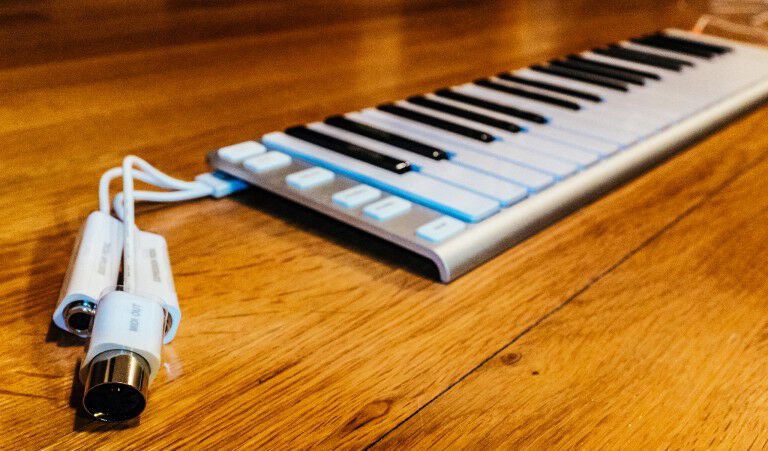
The Xkey37 is CME’s followup to the hugely popular Xkey25 mobile MIDI keyboard. The original model was highly regarded for its rock-solid build quality and beautiful design. The Xkey37 adds twelve extra keys, and includes a breakout Xcable which adds a 5-pin MIDI Out port and two pedal inputs for sustain and expression. In this review, you’ll get an in-depth look at the new Xkey37 mobile MIDI keyboard from CME.

The design of the Xkey37 is very similar to the original model. The ultra-thin enclosure (check out the photo comparison with an iPad Air), machined from aluminum, houses thirty-seven full-sized keys. Compared to the Xkey25, the keys on the new model are noticeably quieter, and they just feel more robust in general. I’m note sure if the Xkey37’s delayed introduction citing production issues had anything to do with the action. If it did, CME figured it out because the keys on this thing are seriously solid.
The icons on the controller keys for Octave +/-, Modulation, Pitch Bend +/-. and Sustain have been replaced with text for easier recognition. The USB port for computer connectivity is still on the right hand side of the keyboard. On the left, there is now a Xport for the new Xcable, a breakout cable which adds MIDI Out along with 1/4″ jacks for a sustain pedal and expression pedal.

When connected, the XCable seems to have a too much wiggle room. It’s a little too easy to pull out. Some kind of locking connector design would be ideal. Perhaps this is something that CME can look into for future revisions of the product. I don’t have any complaints regarding the build quality of the breakout cable itself. It’s manufactured from a hard plastic, and the connector jacks are pretty solid.
The Xkey37 features velocity-sensitive keys with polyphonic aftertouch. With the addition of the sustain and expression pedal inputs, this may just be the perfect keyboard for mobile composition, notation, and keyboard programming. Perhaps my favorite design element of both the Xkey25 and Xkey37 is the curved bottom. You can essentially bolt the keyboard to the edge of a table, eliminating any chance of slippage during use. One thing to remember regarding the MIDI Out port is that USB power is required for the Xkey37 to function. This means the keyboard needs to be plugged in to a USB charger or a computer for it to function properly.

The controller buttons on the Xkey37 send pre-programmed values, which can be configured via the the free Xkey Plus app. This app, available for OS X, Windows, and iOS brings an incredible amount of flexibility to an already great piece of hardware. Parameters that can be customized include velocity curves, the various MIDI message buttons, the sensitivity of the keys and buttons, and timing parameters. The Xkey37’s firmware can also be updated from the Xkey Plus app.
I think the Xkey37 is a great product for musicians and producers on the go. My Xkey25 got a lot of use while I was traveling with the Newsies tour last year. Even though I was able to get a lot work done, I did miss having access to a sustain and expression pedal. This is no longer an issue with Xkey37, and I’m sure it’ll be one of the first things I pack on my next trip. With that said, the Xkey37 isn’t without its faults. The Xcable connector isn’t as solid as it should be, and I really hope this issue is addressed sometime in the future.
At $199, the Xkey might seem a little expensive at first. However, take a moment and think of its features jam packed into a high quality aluminum housing. Now, think of a product that truly competes with the Xkey37.